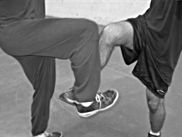
 Chi-Gerk (The Sticking Legs)
Chi-Gerk (The Sticking Legs)
Chi-Gerk - a sensitivity drill for footwork training and leg attacks - is not as soft and flexible as Chi-Sao, but the sensitivity concept is still to be stressed, as are the rules and laws of the hand movements. The ankle is the wrist, the knee is the elbow, and the hip is the shoulder. In the ideal position, the knee is about heart level with a right angle in relationship to the lower leg, with the foot on the centerline. Chi-Gerk enables the practitioner to develop the sensitivity in the legs for sweeps (Huen Bo/Kau Bo), deflections, redirections (Tan Gerk, Bong Gerk, Fook Gerk) and counter kicks (attacking the pole leg/Dok Lap Ma).
Chi-Gerk is the most advanced level of Wing-Chun training to enhance the practitioner with kicking weapons and skills that enable the practitioner to:
• Break the opponent's lower body horse/gate and attack the pole leg, not spin the opponent off center while the upper body techniques are executed simultaneously.
• Develop close range kicking skills. The knee should land on the body about a fist and a half away so that you can kick the chin from Chi Sau position.
• Develop a sense of feeling in the opponent’s legs and great balance in your pole/support leg while executing the upper body techniques up close.
• Develop lower body intercepting, closing the gap, and bridging skills, going forward, defending and attacking the leg with a leg (Gerk Da Gerk-kicks counter kicks).
Chi-Gerk is first experienced by way of various strength and conditioning drills, somewhat similar in nature to Chi-Dan-Sao and the learning found when beginning arm training. A great deal of strength and conditioning is experienced prior to continuing. You would think that because the legs are so much stronger than the arms, Chi-Gerk would be easier to learn than Chi-Sao. In general, however, the reverse is true.
Because the legs are stronger, they are usually more prone to "holding in" their strength instead of being able to relax. And because we are so "pre-occupied" with upper body movements, many will usually not place the emphasis required in the lower body until the Chi-Gerk curriculum is introduced. Those that do will always find that their Chi-Gerk training, when combined with Chi-Sao, is quite superior to a practitioner that has never trained it.